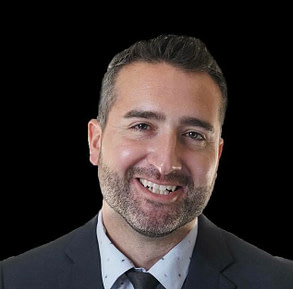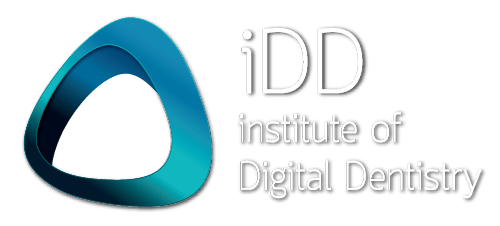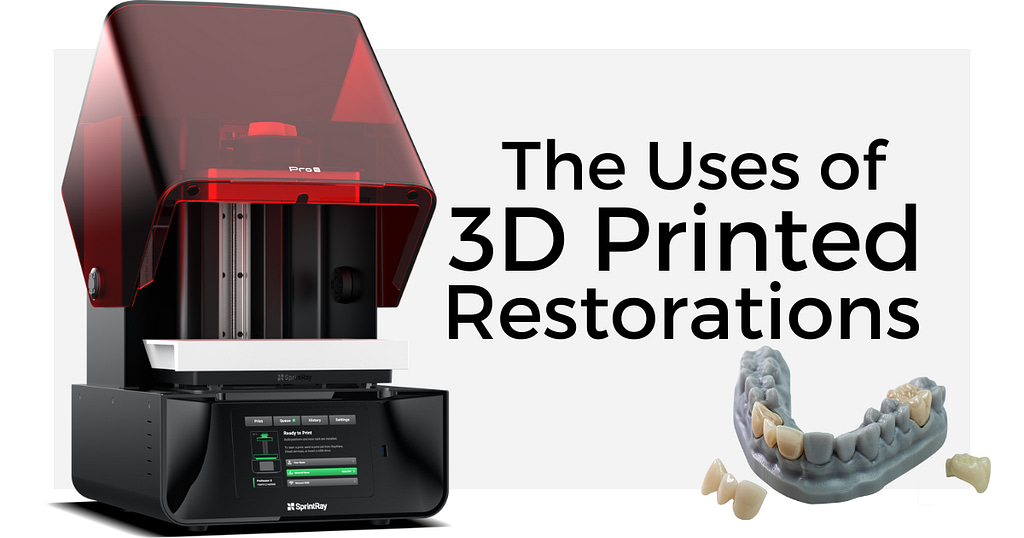3D printing is the next big thing to happen in dentistry.
And it's not hard to see why.
3D printing allows you to take complete control of your clinical workflow, save massive amounts of money on your lab bill and offer a variety of treatments for your patients.
And when you consider that companies like Sprintray are making it easier than ever to implement 3D printing crowns and bridges in your clinic, it's clear that the sky is the limit for 3D printing.
Dr Wally Rene wrote an excellent FB post about how he uses 3D printing in his clinic, and allowed us to share it below.
Enjoy!

About the Author
Dr Wally Rene
Dr. Renne left an academic position as full Professor and Assistant Dean of Innovation and Digital Dentistry at the Medical University of South Carolina to start a training center in Charleston South Carolina called The MOD Institute. He has won several national and regional teaching awards for his efforts both pre-clinically and clinically. He is passionate about 3D printing in dentistry with has over 20 printers in his clinic including FDM, SLA, DLP, LCD and SLF. He is also active in dental research and has published several studies on scan accuracy and milling accuracy using various systems.
We need to have an open honest discussion about 3D printed restorations. I have been printing definitive inlay, onlay, veneers and crowns for the past 28 months or so. I have just over 1000 restorations (mostly veneers, implant crowns and partial coverage onlays) and have had 2 fractures and no debonds in this time.
More importantly we have dramatically increased the quality of care for our patients. I will explain my reasoning for adopting these and some limitations as well.
Please let me take a moment to explain the difference between these materials, direct resin and milled resin like Tetric CAD, Cerasmart and the dreaded Lava Ultimate. I'd like to show you how I use these restorations in my dental clinic.
Printed Restorations for Conservative Partial Coverage
Printed restorations are a way to do conservative indirect quadrants of inlays and onlays. A major upgrade to larger direct resins. Direct resins are great in certain indications however when they get large they become technique sensitive and are quite poor as a restorative solution.
“Every time you add another surface to a direct resin, failure rate increases by 30-40%” (1). We also know from a recent systematic review and Meta analysis that indirect onlay restorations made of resin perform with the same success as ceramic, both dramatically better compared to direct resin(2).
Two of the main reasons direct resins perform poorly is they have a poor degree of polymerization with around a 50% methacrylate conversion (3) and when they are cured in a tooth a large amount of force is placed on the tooth and adhesive layer due to polymerization shrinkage stress(4).
Contrastingly, printed resins when properly cured can have up to 95% degree of polymerization (5) which explains the better wear characteristics (6,7,8) and we know indirect resins like printed restorations reduce shrinkage stress imparted on the tooth to almost zero(4).
It is a travesty in the USA that only 6% of dentist treatment plan inlays and onlays. This is largely due to cost of lab bills, difficulty temping and large cost of mills to make this single visit.
Our patients deserve options.
In Latin America, Europe and Asia more partial coverage indirect restorations are done then full coverage crowns. Not everything should be a filling or a crown, with nothing in between. I believe 3D printing will bring more conservative partial coverage to mainstream dentistry. It is certainly my favorite use of these printed restorations.
Based off of this and other evidence and following my printed restorations over time I charge the same for a printed onlay or inlay as I do for a ceramic onlay and inlay. I am confident this is a great indication for these restorations.
NOTE: You have to understand adhesive dentistry and partial coverage preparation for these to be nice.
Printed Implant Crowns
Another major application for me is implant crowns. Philosophically making implant crowns out of a polymer resin makes sense because implants lack a PDL space and the ability to absorb impact (9-17).
This is opposite to the trend of making implant crowns out of zirconia. Natural teeth wear and are dynamic. Zirconia doesn’t wear at all, it is the immovable rock in the mouth. This can lead to hyper occlusion over time that may potentially result in implant failure (18-20).
We have high level of evidence that shows that 50% of all implant crowns next to a natural tooth end up with an open contact(21).
With printed, you can simply unscrew the crown, sandblast the contact, add resin and cure. Milled composite was promised as an ideal material in these indications but failed through debonding.
Interestingly, composite crowns on implants manufactured using packable composite manufactured by Bicon as the integrated abutment crown have great clinical success(22). This is because milled resin in contrast to direct resin and printed resin is completely devoid of free methacrylate to bond to and they suffer from debonding (23).
Studies show the bond to printed resin is not only tenacious but actually increases over time (24).
Based off this and other evidence and my clincial knowledge, I charge the same for a printed implant crown as I do for a ceramic implant crown.
NOTE: you have to understand how to finish and bond the printed restorations for them to be nice solutions.
Printed Veneers
I love this application and use it almost daily in my practice as a lower cost alternative to ceramic. I still do plenty of ceramic veneers but printing has enabled me to do more conservative veneers on patients that normally wouldn’t have been able to afford veneers.
I no longer do direct resin veneers. I charge half the cost for a printed veneer as I do for ceramic. They take me half the time to do. I do them single visit because 10 veneers can be printed in 10 minutes.
NOTE: You have to know how to properly finish them or they look bad and don’t hold up.
Reduced Crown Cost
Lastly I use them as a lower cost crown.
Theoretically you could charge full price with the new (ADA) code update. But for my practice I offer them at a lower cost. This comes in handy for me when treating low income patients or even high income patients that need phased treatment.
For example with full mouth reconstructions, often I will do one arch in zirconia and the other in printed to buy them 5 or so years to slowly convert the remaining units to zirconia or emax.
This enables me to still do both arches and not have to compromise occlusion by treatment of one arch only. Studies show that when opposing zirconia printed teeth wear less then even premium carded denture teeth.
References - further reading!
- Opdam NJ, van de Sande FH, Bronkhorst E, Cenci MS, Bottenberg P, Pallesen U, Gaengler P, Lindberg A, Huysmans MC, van Dijken JW. Longevity of posterior composite restorations: a systematic review and meta-analysis. J Dent Res. 2014 Oct;93(10):943-9. doi: 10.1177/0022034514544217. Epub 2014 Jul 21. PMID: 25048250; PMCID: PMC4293707.
- Bustamante-Hernández N, Montiel-Company JM, Bellot-Arcís C, Mañes-Ferrer JF, Solá-Ruíz MF, Agustín-Panadero R, Fernández-Estevan L. Clinical Behavior of Ceramic, Hybrid and Composite Onlays. A Systematic Review and Meta-Analysis. Int J Environ Res Public Health. 2020 Oct 19;17(20):7582. doi: 10.3390/ijerph17207582. PMID: 33086485; PMCID: PMC7589045.
- David C, Cuevas-Suárez CE, de Cardoso GC, Isolan CP, de Moraes RR, da Rosa W, Münchow EA, da Silva AF. Characterization of Contemporary Conventional, Bulk-fill, and Self-adhesive Resin Composite Materials. Oper Dent. 2022 Jul 1;47(4):392-402. doi: 10.2341/21-063-L. PMID: 35917238.
- Dejak B, Młotkowski A. A comparison of stresses in molar teeth restored with inlays and direct restorations, including polymerization shrinkage of composite resin and tooth loading during mastication. Dent Mater. 2015 Mar;31(3):e77-87. doi: 10.1016/j.dental.2014.11.016. Epub 2014 Dec 24. PMID: 25544104.
- Lee SY, Lim JH, Kim D, Lee DH, Kim SG, Kim JE. Evaluation of the color stability of 3D printed resin according to the oxygen inhibition effect and temperature difference in the post-polymerization process. J Mech Behav Biomed Mater. 2022 Oct 23;136:105537.
- Myagmar G, Lee JH, Ahn JS, Yeo IL, Yoon HI, Han JS. Wear of 3D printed and CAD/CAM milled interim resin materials after chewing simulation. J Adv Prosthodont. 2021 Jun;13(3):144-151.
- Gad MM, Alalawi H, Akhtar S, Al-Ghamdi R, Alghamdi R, Al-Jefri A, Al-Qarni FD. Strength and Wear Behavior of Three-Dimensional Printed and Prefabricated Denture Teeth: An In Vitro Comparative Analysis. Eur J Dent. 2023 Jan 20. doi: 10.1055/s-0042-1759885. Epub ahead of print. PMID: 36669653.
- Pham DM, Gonzalez MD, Ontiveros JC, Kasper FK, Frey GN, Belles DM. Wear Resistance of 3D Printed and Prefabricated Denture Teeth Opposing Zirconia. J Prosthodont. 2021 Dec;30(9):804-810. doi: 10.1111/jopr.13339. Epub 2021 Feb 11. PMID: 33486808.
- Boff LL, Oderich E, Cardoso AC, Magne P. Fatigue resistance and failure mode of adhesively restored custom metal-composite resin premolar implant abutments. Int J Oral Maxillofac Implants. 2014 Mar-Apr;29(2):364-73. doi: 10.11607/jomi.2836. PMID: 24683562.
- Bonfante EA, Suzuki M, Lubelski W, Thompson VP, de Carvalho RM, Witek L, Coelho PG. Abutment design for implant-supported indirect composite molar crowns: reliability and fractography. J Prosthodont. 2012 Dec;21(8):596-603. doi: 10.1111/j.1532-849X.2012.00872.x. Epub 2012 Jun 1. PMID: 22672650.
- Rosentritt M, Schneider-Feyrer S, Behr M, Preis V. In Vitro Shock Absorption Tests on Implant-Supported Crowns: Influence of Crown Materials and Luting Agents. Int J Oral Maxillofac Implants. 2018 January/February;33(1):116–122. doi: 10.11607/jomi.5463. Epub 2017 May 18. PMID: 28518187.
- Cantó-Navés O, Medina-Galvez R, Marimon X, Ferrer M, Figueras-Álvarez Ó, Cabratosa-Termes J. A 3D Finite Element Analysis Model of Single Implant-Supported Prosthesis under Dynamic Impact Loading for Evaluation of Stress in the Crown, Abutment and Cortical Bone Using Different Rehabilitation Materials. Materials (Basel). 2021 Jun 24;14(13):3519. doi: 10.3390/ma14133519. PMID: 34202625; PMCID: PMC8269525.
- Karaer O, Yamaguchi S, Imazato S, Terzioglu H. In Silico Finite Element Analysis of Implant-Supported CAD-CAM Resin Composite Crowns. J Prosthodont. 2022 May 4. doi: 10.1111/jopr.13531. Epub ahead of print. PMID: 35509150.
- Taguchi K, Komine F, Fushiki R, Blatz MB, Kamio S, Matsumura H. Fracture resistance of single-tooth implant-supported zirconia-based indirect composite-layered molar restorations. Clin Oral Implants Res. 2014 Aug;25(8):983-91. doi: 10.1111/clr.12199. Epub 2013 Jun 3. PMID: 23730807
- Elsayed A, Yazigi C, Kern M, Chaar MS. Mechanical behavior of nano-hybrid composite in comparison to lithium disilicate as posterior cement-retained implant-supported crowns restoring different abutments. Dent Mater. 2021 Aug;37(8):e435-e442. doi: 10.1016/j.dental.2021.03.015. Epub 2021 Apr 17. PMID: 33875247.
- Bijjargi S, Chowdhary R. Stress dissipation in the bone through various crown materials of dental implant restoration: a 2-D finite element analysis. J Investig Clin Dent. 2013 Aug;4(3):172-7. doi: 10.1111/j.2041-1626.2012.00149.x. Epub 2012 Nov 21. PMID: 23172842.
- Magne P, Silva M, Oderich E, Boff LL, Enciso R. Damping behavior of implant-supported restorations. Clin Oral Implants Res. 2013 Feb;24(2):143-8. doi: 10.1111/j.1600-0501.2011.02311.x. Epub 2011 Oct 3. PMID: 22092518.
- Bertolini MM, Del Bel Cury AA, Pizzoloto L, Acapa IRH, Shibli JA, Bordin D. Does traumatic occlusal forces lead to peri-implant bone loss? A systematic review. Braz Oral Res. 2019 Sep 30;33(suppl 1):e069. doi: 10.1590/1807-3107bor-2019.vol33.0069. PMID: 31576953.
- Di Fiore A, Montagner M, Sivolella S, Stellini E, Yilmaz B, Brunello G. Peri-Implant Bone Loss and Overload: A Systematic Review Focusing on Occlusal Analysis through Digital and Analogic Methods. J Clin Med. 2022 Aug 17;11(16):4812. doi: 10.3390/jcm11164812. PMID: 36013048; PMCID: PMC9409652.
- Brune A, Stiesch M, Eisenburger M, Greuling A. The effect of different occlusal contact situations on peri-implant bone stress - A contact finite element analysis of indirect axial loading. Mater Sci Eng C Mater Biol Appl. 2019 Jun;99:367-373. doi: 10.1016/j.msec.2019.01.104. Epub 2019 Jan 30. PMID: 30889710.
- Bento VAA, Gomes JML, Lemos CAA, Limirio JPJO, Rosa CDDRD, Pellizzer EP. Prevalence of proximal contact loss between implant-supported prostheses and adjacent natural teeth: A systematic review and meta-analysis. J Prosthet Dent. 2021 Jul 19:S0022-3913(21)00333-4. doi: 10.1016/j.prosdent.2021.05.025. Epub ahead of print. PMID: 34294422.
- Urdaneta RA, Marincola M, Weed M, Chuang SK. A screwless and cementless technique for the restoration of single-tooth implants: a retrospective cohort study. J Prosthodont. 2008 Oct;17(7):562-71. doi: 10.1111/j.1532-849X.2008.00343.x. Epub 2008 Aug 26. PMID: 18761575.
- Wierichs RJ, Kramer EJ, Reiss B, Schwendicke F, Krois J, Meyer-Lueckel H, Wolf TG. A prospective, multi-center, practice-based cohort study on all-ceramic crowns. Dent Mater. 2021 Aug;37(8):1273-1282. doi: 10.1016/j.dental.2021.04.005. Epub 2021 May 7. PMID: 33972099.
- Lankes V, Reymus M, Liebermann A, Stawarczyk B. Bond strength between temporary 3D printable resin and conventional resin composite: influence of cleaning methods and air-abrasion parameters. (Clinical Oral Investigations 2022; doi.org/10.1007/s00784-022-04800-7)

